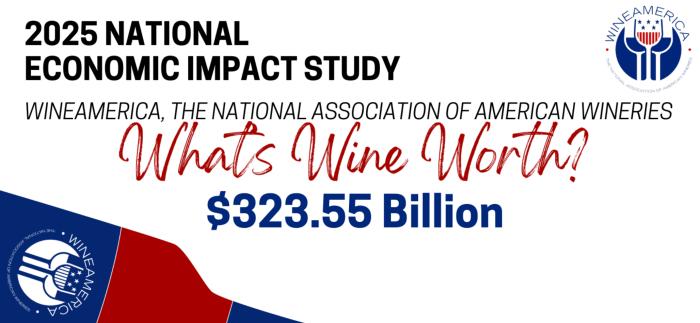Raise a glass! Wine is a major American economic engine.

When I hear people talking about wine, and when I read articles written about wine, it's not usually about its economic value. It's much more likely to be an exploration of its flavors, or a celebration of its compatibility with food and conviviality, or its ability to reflect place. Maybe it's as a venue (think "wine country") that's a backdrop for experiences. Or maybe it's about how wine is intertwined with culture and history. But after 24 years working in wine, I can assure you it's a business too. And a recent economic impact study commissioned by WineAmerica and conducted by John Dunham & Associates was a dramatic reminder of just how important an economic driver it is here in the United States. I don't yet see this study getting the attention it deserves, so I'm diving in to pull out the highlights. I encourage you to check out the full report, which has lots more detail and also breaks out the economic impact of wine for each of the 50 states and the District of Columbia.
I'll hit you with a few headline stats first. Nationwide, wine is responsible for:
- $323.55 billion in total economic activity
- 1,750,363 jobs
- $102.1 billion in wages
- $53.2 billion in tax revenue
Let's look by sector at the report’s findings.
We are one of the country's 10,761 wine producers, which are found in all 50 states. We account for 125 of the 763,080 acres of vineyard planted nationwide. And we employ 47 people. American vineyards and wineries produce 95,987 jobs, with the farming of the vineyard accounting for 51,195 direct jobs and wineries adding an additional 44,792. American grapegrowing has an overall economic impact of $13.36 billion, while wine production and marketing adds another $22.5 billion in economic impact. But if you thought that most of wine's economic impact would come from domestic wineries, you'd be wrong. The jobs and the economic impact of American grapegrowing and winemaking account for less than 10% of wine's total impact.
Where else does wine contribute to the American economy? Look further down the distribution chain. The wholesale sector of wine produces 51,972 jobs, providing about $5.1 billion in wages and benefits, and contributing about $23.2 billion in economic activity. That total includes the distribution of American wine, sure, but also the roughly 135 million cases that are imported in a normal year and account for 37% of American consumption. Both domestic and imported wines need to go through distributors in each state, as a part of the mandated "three tier" system that replaced prohibition.
By far the largest contributor to jobs is the next tier, in which wine is sold to consumers at wine shops, restaurants, bars, and grocery stores. There, wine contributes to the employment of 688,725 people (measured in full-time-equivalency). These workers earn about $26.7 billion in wages and benefits while contributing $72.2 billion in economic activity to the U.S. economy.
Still, when you add up the three tiers of the three tier system, you only get to about 39% of wine's total economic impact. So where are the other direct contributions? Don't forget wine tourism. The study found that 21.1 million people visit American wineries each year, making 74 million winery visits. These visits are responsible for 108,913 jobs and an economic impact of $11.9 billion. Add in about $500 million in impact from wine associations and educational institutions and you end up with a direct economic impact of $138.4 billion and over 927,000 jobs.
Of course, those are just the direct impacts of the production, sales, marketing, and education around wine. There is also indirect economic impact. As defined in economic impact report parlance, indirect impact measures the contributions of the suppliers who sell wineries, wholesales, and retailers the tools, materials, and services they need to do their businesses. These include machinery, tools, processing aids, and parts (think bottles, capsules, and labels), as well as agricultural services, personnel services, financial services, advertising services, consulting services, transportation services, and even the services of workers employed by state and federal governments responsible for the regulation of the wine industry. By the methodology of the study, it also includes independent grape growers, who sell their fruit to wineries to press, ferment, and eventually sell. That network of suppliers, service providers, and regulators is responsible for 383,476 jobs and generates about $90.8 billion in economic activity.
Finally, as anyone who has taken Economics 101 will know, economic activity begets more economic activity. So when wages are paid to workers in the production, sales, and distribution of wine, or through the suppliers who enable that production, sales, and distribution, that money is returned to the economy through the products and services that those employees purchase where they work and live. That is called "induced impact" and is a standard piece of any economic impact survey. The induced economic impact of wine produces another 439,854 jobs and $94.4 billion in economic activity.
I'll summarize that in the chart below, if you prefer to absorb your data in tabular fashion:
| Sector | Jobs Created | Economic Impact ($ in Billions) |
|---|---|---|
| Estate Vineyards | 30,863 | 8.1 |
| Wine Production & Marketing | 44,792 | 22.5 |
| Total Direct Impact: Production | 75,655 | 30.6 |
| Wholesale Sales | 51,972 | 23.2 |
| Retail & Restaurant Sales | 688,725 | 72.2 |
| Wine Tourism | 108,913 | 11.9 |
| Education & Associations | 1,768 | 0.5 |
| Total Direct Impact: Sales & Tourism | 851,378 | 107.8 |
| Independent Vineyards | 20,332 | 5.3 |
| Non-Grape Suppliers | 363,144 | 85.5 |
| Total Indirect Impact | 383,476 | 90.8 |
| Total Induced Impact | 439,854 | 94.4 |
| Total | 1,750,363 | 323.6 |
That total economic impact of $323.6 billion is 1.1% of the United States' total GDP. That's a contribution of $951.48 per man, woman, and child in the country. And the over $53 billion in state and federal tax revenue that wine generates comes to $404.78 per American household.
One of the things I love about working in wine is that I'm the relatively rare person among my friends who is involved in making something tangible. We live in a service-dominated economy, and one that imports a large percentage of its goods. To be making something that I get to share with people, and something that I know brings people together and helps them enjoy those gatherings, feels special and rare. To see so clearly what an economic powerhouse wine is, at a moment when wine feels more under threat than ever, makes it feel all the more worth protecting.
Raise a glass, everyone.

